ایران

Iran
Empire

Iran
Islamic republic
Quick reference
General issues: Persia, Empire 1868-1935, Iran, Empire 1935-1979, Iran, Islamic republic 1979-Present
Country name on general issues: Poste Persane, Postes Persanes, Iran, Iran in Farsi
Special issues:
- Mashhad, locals issues 1902
- Tehran, local issues 1902-1903
- Tabriz, local issues 1902-1906
- Persian Azerbaijan-Tabriz, regional issues 1912
- Persian Kurdistan, insurgent issues 1913
- Bushehr, British occupation 1915
- Bushehr & Shiraz, insurgent issues 1916-1917
- Kermanshah, local issues 1917
- Khoy, Rasht, Tabriz, Tehran, local premium issues 1918
- Bushehr, local issues 1921
- Iranian Azerbaijan, local issues 1945-1946
Currency: 1 Toman = 10 Kran, 1 Kran = 20 Chahi 1868-1881, 1 Kran = 1 Franc = 20 Chahi = 100 Centimes 1881-1932, 1 Rial = 100 Dinar 1932-Present
Population: 9 860 000 in 1900, 77 450 000 in 2013
Political history Iran
Iran – called Persia until 1935 – is located in southern Asia. In the 19th century, Persia is an empire wedged between the British and Russian spheres of influence in Asia. Great Britain and Russia are, at the time, involved in ‘The Great Game’, the struggle for power in Asia. The Russians have their sphere of influence in the north of Persia, the British in the southeast. These spheres of influence are formalized in a 1907 treaty between Great Britain and Russia. In Persia there is continuous opposition against this foreign influence in the country. Sometimes resulting in the establishment of an opposition government, such as the ‘National Committee for the protection of Persian Independence’, established in 1916, in the Bushehr and Shiraz region. During WWI, Persia is invaded by the Ottomans who occupy different parts of Persia between 1915 and 1918. The goal of the Ottomans was, apparently, to extend their empire, through Persia, to include the Turkic countries of Central Asia. The Ottomans are mainly confronted with opposition from Russian forces deployed in Persia. Both in WWI and in WWII, Great Britain and Russia occupy parts of the country to secure their interests as factions exist in Persia that seek the support of Germany as a way to reduce the British and Russian influence in the country. Shortly after WWII, in 1945-1946, the Russians support the establishment of an opposition government in Persian Azerbaijan – occupied at the time by Russian forces.
Persia has, from the end of the 18th century, been an absolute monarchy ruled by the Qajar dynasty. In 1906, Shah Mozafar ad-Din introduced reforms and granted Persia a constitution and a parliament. His successor, Shah Mohammed Ali, was ousted in 1909 when he tried to cancel the reforms and dispose of the constitution and the parliament. Mohammed Ali made an attempt to regain his position, from 1911, entering northern Persia from Russia, but his forces were defeated. The incapacity of the Qajar dynasty to reduce the influence of the foreign powers in Persia led to their downfall in 1925, when they were succeeded by the Pahlavi dynasty that ruled Iran until 1978.
In the 1950’s, British and Russian influence decreases and their place is taken by the United States. With the support of the United States, the Shah of Iran, Mohammed Reza Pahlevi, in the 1960’s and 1970’s modernizes the country at a high pace. This strong orientation on the West and the authoritarian character of the regime of the Shah causes opposition that eventually will lead to the fall of the Shah in 1978 and the establishment of the Islamic republic of Iran led by Ayatollah Khomeini in 1979.
Iran is invaded by neighboring Iraq in 1980. On the one hand, because the Shia regime of Ayatollah Khomenei has allegedly infiltrated in Sunni Iraq. On the other hand, because of territorial claims Iraq holds on Iran. The war ends in 1988 in a status quo ante bellum.
The relation with the United States is, since the establishment of the Islamic republic in Iran, a hostile one. Tensions in the first decade of the 20th century focus on the issue whether the nuclear program of Iran has peaceful or military goals. Recent talks may lead to a relaxation of these tensions.
Postal history Iran
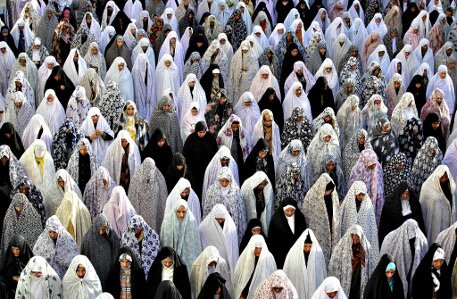
Women at prayer, Tehran
Persia has issued stamps as of 1868, until 1935 inscribed Poste Persane or Postes Persanes, and as of 1935 with Iran in Farsi or Latin script. Collecting Persian stamps issued until 1925 is a challenge due to the many reprints and forgeries that exist of these issues. Since the establishment of the Islamic republic in 1979, stamps have been inscribed to denote the Islamic character of Iran: Islamic Republic, Republique Islamique, R.I. or I.R.
From 1857, the postal service of British India has opened offices abroad in several Persian cities, located both in the British sphere of influence and in the neutral zone between the British and Russian spheres of influence. British Indian stamps were used in these offices, recognized by the cancels. The British Indian offices in Persia were closed in 1923. Likewise, the Russians had a number of offices in their sphere of influence from 1908 until 1919, where Russian stamps were used.
In the first quarter of the 20th century, Persia has seen several special issues. A closer look in chronological order:
- Mashhad, also called Meshed – local issues 1902. In Mashhad, due to a shortage of the supply of stamps, the postmaster issued provisionals in 1902. These carry the postmaster’s initials, ‘V.C'[1]Victor Casteign , and were signed by the postmaster before being sold.
- Tehran – local issues 1902-1903. Local issues from 1902 to 1903 mainly for local mail, these being overprints reading ‘P.L. Teheran'[2]‘Poste Locale Teheran’ .
- Tabriz – local issues 1902-1906. Local issues, mainly stamps with a control overprint reading ‘Provisoire’.
- Persian Kurdistan – insurgent issues 1912-1913. Stamps issued by the forces of the ousted Shah Mohammed Ali, who had a foothold in northern Persia when trying to regain his position. The issues were Persian stamps overprinted ‘Sultan Mohammed Ali Shah Qajar’.
- Persian Azerbaijan-Tabriz – regional issues 1912. Stamps with a control overprint ‘Officiel’ to indicate that these were authorized issues after a large number of stamps had been stolen.
- Bushehr – occupation issues 1915. The British, during WWI, occupied parts of southeast Persia and issued stamps for use in the area in 1915, these being Persian stamps with an overprint reading ‘Bushire under British occupation’. The postal service was returned to Persia in the same year.
- Bushehr & Shiraz – insurgent issues 1916-1917. Stamps overprinted by the opposition government of the National Committee for the Protection of Persian Independence, the overprint reading ‘National Committee 1916/1917’.
- Kermanshah – local issues 1917. Stamps issued locally with the overprint of a new face value during the Turkish occupation of Kermanshah.
- Khoy, Rasht, Tabriz and Tehran – local premium issues 1918. Local premium issues, being overprints on revenues.[3]Resources used do not indicate the purpose of the premium.
- Bushehr – local issues 1921. Stamps overprinted locally with a new face value.
- Iranian Azerbaijan – local issues 1945-1946. Iranian stamps overprinted ‘Azerbaijan National Government, Dec. 12, 1945’ – issued by the opposition government set up in Iranian Azerbaijan with Russian support shortly after WWII.
A set of stamps is known to be issued in the name of the Russian forces occupying part of Persia in 1917 – overprints on Russian stamps reading ‘Occupation Azirbayedjan’. These are considered to be bogus.
Album pages
← Previous page: IndonesiaNext page: Iraq →

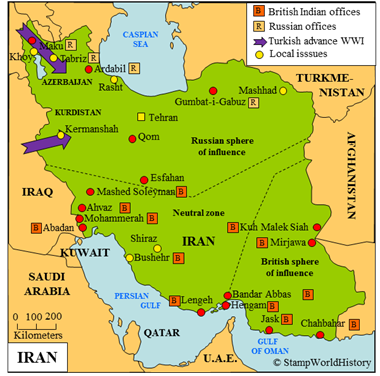

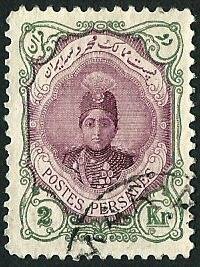
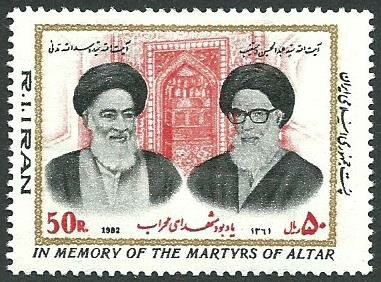
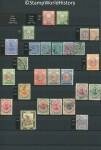



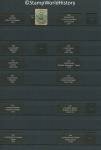
Sir,
Can you send please a picture of an example of stamp ——-Bushehr & Shiraz – insurgent issues 1916-1917. Stamps overprinted by the opposition government of the National Committee for the Protection of Persian Independence, the overprint reading ‘National Committee 1916/1917’.
Because I am trying to make a catalog of stamp from every territory with pictorial example.My work is fully based on your website with some minor changes.I always say that this catalog is made by Mr. Gerben van Gelder with minor assistance of mine.I always want to show you this prepared catalog(India to Afghanistan)…if you allow me sir..please.
Kousik Nanda
Kousik
The Bushehr & Shiraz issues are still on my want list, so I cannot send you an image from my collections. There is a site though that discusses these stamps – with pictures: http://www.postoveznamky.sk/postage-stamp-territories-bushire-and-kazerun. The story is complex. Michel lists only two stamps for this issue – not the ones on the site. But Michel also states that more stamps were overprinted than the ones listed. These are the ones shown on the site.
Seems like you have embarked on a very interesting project. Of course, I am quite proud that you have taken StampWorldHistory as your starting point. I would love to see some of your work. I you require my email address please let me know and I will drop you an email.